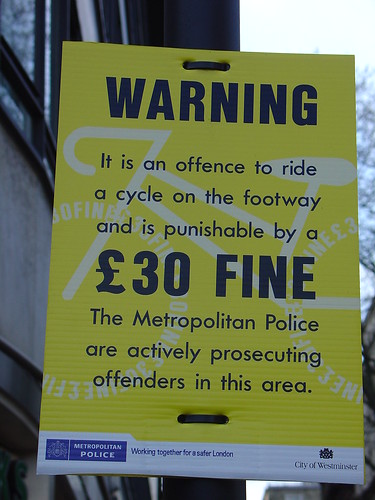London signage 02: Dummy “it” in non-parallel construction.
Deuxième partie de notre série sur les panneaux londoniens. Celui-ci pose un problème de syntaxe.
For our second instalment let’s turn our attention to a bit of syntax. This sign adorns a narrow footpath from Charing Cross train station down to the river Thames:
If we give the first sentence its final punctuation back and try to group together what goes together, we get, on the surface, this:
- [It [is an offence [to ride a cycle [on the footway]]] and [is punishable [by a £30 fine]]].
Now I know I have a high tolerance for non-parallel constructions in English, but this one bugs me. The culprit? The first and the second instance of “it” aren’t the same: in the first half of the sentence, it is a dummy subject; the only reason it’s there at all is because the sentence needs a subject, however perfunctory. there’s another way of saying the same thing, using the Vb+ing form: Riding a cycle on the footway is an offence. On the other hand, the (virtual) it in it is punishable by a £30 fine replaces the entire referential subject of the first half, riding a cycle on the footway.
But if we pull that part out and front it, the sentence’s okay for me: Riding a cycle on the footway is an offence and punishable by a £30 fine. Weird.
(On Flickr and IRC, the discussion about the grammaticality of the sentence got sidetracked into a) whether cycle is the appropriate word (it is indeed the legal term) and b) whether it makes sense to restrict cycling (in this particular place — a narrow walkway filled with foreign teenagers in London for the first time — I’d say it’s defensible, though the Met’s priorities should lie elsewhere).
[The spell-checker didn’t know: footway.]



The thought that comes to my mind repeatedly is how unlikely I would have been to have noticed this. When “it” is used as a subject, I think I simply ignore the fact that it’s there… perhaps this has to do with how semantically empty it is.
And yet when you first pointed this out to me, I realized that of course it’s totally wrong, and I felt foolish to have missed it, even though, by nature, I really don’t care much about correctness in writing or speech. But now it bugs me too! :)
As for your final conjecture, I can at least attempt to explain why I find Riding a cycle… okay, as opposed to the original:
The “parallelism” of is an offence and is punishable implies that the circumstances of each of the parallelized elements are identical. But semantically they aren’t — the second element is in fact describing the first.
Topicalizing Riding… as you suggest solves this problem.
As further evidence that the two elements aren’t “equal,” you can try switching them around:
That changes the sense, I think: the fine and the offence are more distinct things.
I really like these sign posts, keep them coming. :)
God, Pat, you aren’t “foolish” for “missing” this — otherwise we’re all foolish because of the 1000 things we miss every single minute of the day. And maybe it’s just my imagination running away with me.
Very interesting when you change the order: I don’t really see the difference in sense, but suddenly the “it” before “… is punishable by a £30 fine” becomes a dummy “it”, too — and your switched-around sentence looks totally fine to me.
Indeed, now you’re grouping [is [[punishable by a £30 fine] and [an offence]]]. So it doesn’t really depend on the order. This would be fine, too: It is an offence and punishable by a £30 fine to ride a cycle on the footway. (Well, maybe not “fine” but an improvement.)
Hmm. How about the following two versions:
(1) It is an offense to ride a cycle on the footway and punishable by a £30 fine.
(2) It is an offense to ride a cycle on the footway and punishable by a £30 fine, too.
Both suffer from the same problem as the original (i.e. dummy it is the subject of both clauses), except that now the copula is is also missing from the second conjunct. I’m a little suspicious of (1), but (2) sounds fine to me, especially with a pause between footway and and..
What does “this area” refer to? it could refer to the physical space surrounding the sign, or to “this general sort of offense.”